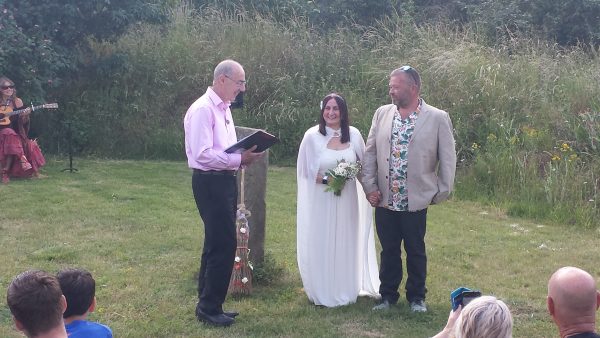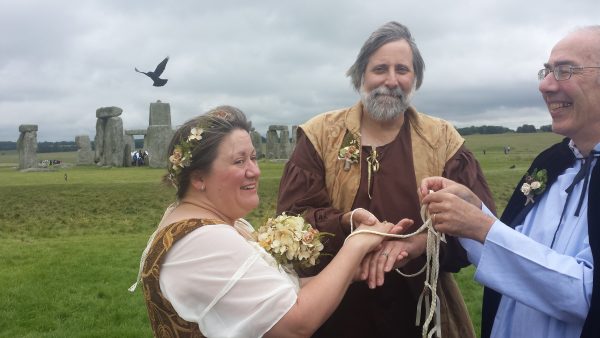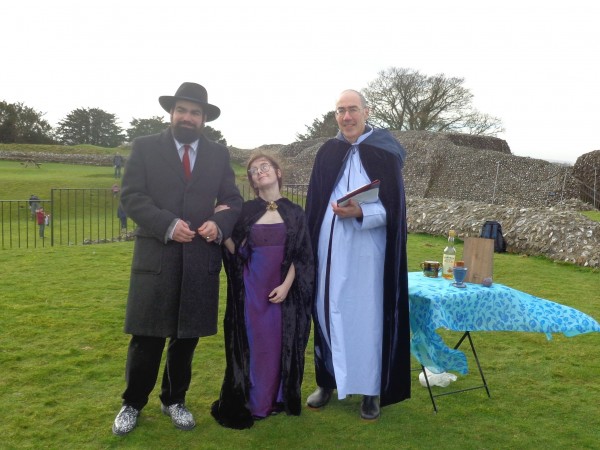
by Michael | Aug 21, 2018 | Blog
The extraordinary is part and parcel of the work of a celebrant.
“I want a Jewish wedding. My boy friend’s not Jewish, but he’s fine with it. At first, my parents wouldn’t have anything to do with the wedding. Now they’re coming round to it, but refuse to allow Jewish traditions in the ceremony. Can you put something suitable together?”
“I’m going to propose to my girl friend in the [5 star] hotel. When she accepts, I want you to come across and conduct an appropriate ceremony. Knock her off her feet!”
“We’re planning a naturist ceremony. Can you compile something for it?”
“Do you do pagan?”
“Actually, we want something quite conventional. Could you do that for us?”
“Can you collaborate with me alone, as I don’t want my fiancé to have anything to do with the ceremony except to be there?”
As a wedding celebrant, I have been asked these, or similar, questions. They give an idea of the range of desires of clients – (well, potential clients, as I didn’t work with all of these) – that I may deal with.
The beauty of what I offer is that the client has freedom to choose exactly what they want for their big day. They may be open to advice and guidance from me; they may have a very clear vision of what they wish for.
Usually, at the preliminary meeting, we have a chance to see if we’d be comfortable working together and start exploring the possibilities. Do they want religion? Yes? Then, how much? Who will be participating in the ceremony? Will any rituals be included? What tone is wanted?
Once the enquiry turns into a booking, I e-mail a draft as soon as possible. This is for the clients’ approval. If they don’t like something, it goes out! They may suggest readings themselves – usually, they’ll be included automatically, as I always bear in mind that it’s the clients’ day. (That doesn’t mean that I haven’t occasionally advised against a certain reading!)
By the end of the process (and the draft may need several partial rewrites), the client should be left with the ceremony of their dreams – every word of which they will have approved.
So, extraordinary as their requests may sometimes be, I can normally take them in my stride. There’s certainly never a dull moment in my job!

by Michael | Nov 8, 2016 | Blog
I often get asked what a handfasting is.
Do you remember when Prince William married Kate Middleton? Although the ceremony was religious, they briefly incorporated a ritual that resembled a handfasting. The Archbishop draped material over the clasped hands of the couple.
So much else was going on that it attracted little attention. However, a handfasting is technically pagan, and often plays a central role in pagan ceremonies.
Alternatively, it is often chosen as an “add-on” in a traditional wedding.
A growing number of brides and grooms seem intrigued by this and are choosing to incorporate it in their wedding.
And of course it can be included in a Vow Renewal too.
History
Handfastings began as a marriage rite in the Middle Ages. When peasants married, they might have been unable to afford a clergyman’s fee to hear their vows or a ring to signify their love. The ritual of handfasting became a popular alternative.
A cord was wrapped round the wrists of the couple and left on them until their union was consummated. It would usually be kept as a tangible reminder and proof of their commitment and love.
It has given us the expression “tying the knot”.
Present-day Ceremony
Nowadays, the cord symbolises the pair’s mutual love. The way a handfasting can be slipped in is as follows, although this is only a suggestion, and it may be different for a pagan ceremony.
- Walking down the aisle to be given away by the father
- Officiant welcome
- Meaning of love (possibly from a religious slant, if that’s wanted)
- Here, or after the Handfasting, or at both times, a song or a reading/poem
- Handfasting
- Possibly, a Unity Candle or Sand Ceremony or Chalice ritual
- Exchange of Rings/Vows
- Jumping the Broom (not actually pagan, but deriving from wedding ceremonies conducted by slaves in the American South), now used to symbolise sweeping in the new as a new home is created
- Concluding words
Thoughts

I conducted a memorable handfasting at an Iron Age Fort in Wiltshire. The ceremony was part-pagan, part-Jewish with rituals from both sides. (Of course, I made sure everyone could understand by explaining the symbolism.)
It was a totally unique occasion – absolutely perfect for the couple and – clearly – for the guests too.
I shared a wonderful experience with an American couple at Stonehenge at the time of the solstice – and that was quite unforgettable! A photo from that day is my featured image.
In order to add extra sparkle and personality to your big day, do find out about a handfasting. I shall be delighted to tell you more.
by Michael | Apr 26, 2016 | Blog
If you are not pagan, you may be blissfully unaware that Beltane will soon be upon us. It is usually celebrated on 30th April/1st May and is one of four seasonal Gaelic festivals that occur each year.
For the Celtic people, Beltane marked the beginning of summer. Cattle would be driven out into the summer pastures, and rituals performed to protect the cattle, as well as the crops and people, and to ensure growth.
Rituals
Beltane is known for its bonfires. Flames, smoke and ashes from these bonfires were considered to have protective powers. The herdsmen and their cattle would walk around the bonfire (or between them, if there were two). They might even leap over the flames or embers.
When the fire had died down, people would daub themselves with its ashes and sprinkle them over their crops and livestock.
Household fires would be extinguished and re-lit from the Beltane bonfire. There would be feasting and offerings to the gods (or, more precisely, a supernatural race akin to fairies).
Cattle and their cattle-sheds would be decorated with yellow May flowers (this possibly evoked fire).
It was also believed that at around this time pagan gods and nature spirits were at their most active, and many of the Beltane rituals were designed to appease them.
According to some, the fire rituals were meant to mimic the Sun and ensure a supply of sunshine for men, animals and plants. Others believed that they symbolised burning up and destroying all harmful influences.
Revival
About 60 years ago, Beltane celebrations had more or less died out; however, there has been a revival in recent times, notably thanks to Celtic neo-pagans and Wiccans. It is also celebrated in the Southern hemisphere (although around 1st November).
If you are interested in pagan/Celtic elements as part of a ceremony that you are planning – be it wedding, anniversary, special birthday or vow renewal – , then please contact me, your independent civil celebrant, and we can put together a wonderful handfasting ceremony.
Featured image source: telegraph.co.uk

by Michael | Mar 4, 2014 | Blog
Matrimony may have declined somewhat in popularity, but it is still high in people’s consciousness. And there’s little doubt that changes are afoot in the UK wedding industry.
Some developments
Weddings do not have to be held in a religious building or in a registry office (although of course they do have to comply with legislation). You can marry in a hotel or stately home. You can celebrate your wedding on Waterloo Bridge, at Stonehenge, on a mountain top, on the coast, underwater (apparently!) or in a hot air balloon. Indeed, the sky – pardon the pun – is the limit!

You can have a conventional ceremony – or maybe a handfasting at Old Sarum?!
You can have a part-religious ceremony or a pagan handfasting. You can include a combination of rituals. It’s really up to you.
Single-sex weddings will be here by the end of this month, which extends the range of choice still more.
Feminism
Then there are changes brought about by the feminists. The bride doesn’t necessarily wear white. She might not take on the husband’s name. She may refuse to be given away.
The couple may eschew wedding vows and not bother with the honeymoon. Some will have done away with the engagement ring too.
Benefits
Most of these changes, arguably, benefit the woman (especially, dropping the need to promise to “love and obey” the husband). However, they may well have other benefits. Some of these will save the couple money, possibly at a time when expenditure is high (they may be buying a home, for example). More than that, there is something to be said, I think, for couples dropping traditions that actually don’t mean much, or anything, to them. Sincerity counts.
Personalising their wedding, so that it contains just what the couple chooses and matters to them, is sure to be something that they will always gladly remember. And, because it’s sincere and unique, the guests will enthusiastically recall such a ceremony too.
Personally, I like a traditional wedding (indeed, I had one myself), but I also love creating bespoke ceremonies for others, enabling them to make the most important day of their lives memorable, significant and, simply, a delight.
What do you think about these changes?
Michael Gordon can help prepare and conduct a tailor-made life-cycle civil ceremony in or around London or, indeed, in Europe.



